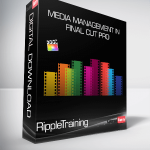RippleTraining – Media Management in Final Cut Pro
Original price was: $79.00.$17.00Current price is: $17.00.
This tutorial is for users of Final Cut Pro X who want to improve their understanding of how to manage their media…
- Description
- Reviews (0)
Description
RippleTraining – Media Management in Final Cut Pro

- Create an Organized Library Structure
- Choose the Best Storage Option
- Collaborate with Others
- Understand Proxy Workflows
- Manage Disk Space & Archive
- Covers Versions FCP 10.4.9 to 10.6
Who this Tutorial is for:
Media Management in Final Cut Pro 10.4.9 was designed for users who are already fluent in Final Cut Pro X. This tutorial is for users of Final Cut Pro X who want to improve their understanding of how to manage their media on single or multiple computers. Users who are new to Final Cut Pro X should purchase Final Cut Pro X Core Training before working through this tutorial.
Software Version: Final Cut Pro 10.4.9 or later.
Run Time: 1 hour 53 minutes
Type of Tutorial: Beginner
Project Media: No project media is needed for this tutorial.
Media Management in FCP X 10.4.9
1. What is Media Management
- 2 Types of Media Management
- Choosing a Media Storage Location
- Backup Strategy
- The Library Hierarchy
- Library & Event Examples
- Organizing Media into Libraries and Events
2. The Library Inspector
- Components of the Library Inspector
- Comparing Library Size and Storage Size
- Storing Media Inside or Outside the Library
3. Importing Media
- Setting up a Managed Library
- Setting up Events for Media
- Importing Media from a Camera Card
- Why Use Camera Archives
- Creating a Camera Archive
- When to Not Use a Camera Archive
- Importing Media from a Drive
- Importing as Leave in Place
- Understanding Media Locations in the Library Inspector
- Looking Inside the Library
- Understanding Sym Links for Leave in Place Media
4. Transcoding Overview
- Transcoding Options on Import
- The Transcode Media Command
- What is Transcoding?
- Why Transcode?
- Optimized vs. Proxy Media
- 3 Transcoding Guidelines
5. Optimizing Media
- Optimizing H.264 Media
- Better Quality vs. Better Performance
- Rendering vs. Optimizing
- Why I Turn Off Background Rendering
- Doing a Test Transcode
- Optimizing All Clips in an Event or Project
- Storage Location for Optimized Media
- Creating Space for Optimized Media
6. Working with Proxy Media
- Creating ProRes Proxies
- Proxy File Size Comparison
- Creating Small Proxies for Large Projects
- Transcoding ProRes RAW Media
- Using Proxy Preferred
7. Consolidating Media
- Consolidating In
- Consolidating Out
- Selective Consolidation-Projects
- Selective Consolidation-Clips
- Consolidating Motion Templates
8. Moving & Copying Media
- Moving and Copying Clips and Projects within a Library
- Copying Between Libraries on Different Drives
- Copying Clips Between Libraries on the Same Drive
- Understanding Hard Links
- Moving Projects and Events between Libraries
- Merging Events
9. Start
- 3 Media Management Operations
- 3 Media Management Guidelines
10. Freeing up Disk Space
- Running Out of Disk Space
- Deleting Generated Media
- Deleting Unused Clips
- Deleting vs. Rejecting
- Deleting External Media
- Deleting the Last Reference
- Reconstituting a Deleted Browser Clip
- Moving Media to Another Drive
- Creating a Managed Library Before Moving
- Summary
11. Working on the Road
- Motivation
- Library Setup
- Creating the Proxy-Only Library
- Why Copy Instead of Consolidate
- Working with the Proxy-Only (Travel) Library
- Moving the Project Back to the Main Library
- Summary
12. Editors in Different Locations
- Scenario Setup
- Getting Original Media to A Remote Editor
- Moving the Cache and Render Files
- Remote Editor Initial Open and Relink Process
- Creating and Sending a Transfer Library
- Receiving the Transfer Library
- Summary
13. Archiving a Library
- Analyzing the Library
- Reducing Library Size
- Deleting Generated Library Files
- Storing Custom Motion Content Inside the Library
- Moving and Deleting the Cache
14. Third Party Solutions
- Frame.io
- Hedge: Backup, Drive, Merge X, Postlab
- KeyFlow Pro
- Lumaforge
- Compressor
15. Custom Camera Archives
16. Creating Proxies with Compressor
Create Organized Libraries
There are many ways to set up your library and we’ll show you best practices for organizing your library that will save you time and keep your edit flowing smoothly from start to finish.
Edit Anywhere or with Anyone
Whether you are a single editor working at home or sharing work with another editor in another part of the world, we’ll show you step-by-step what you need to do in order to make your video projects portable.
Archive Your Work
Your work doesn’t end when you share a project. You’ll learn the important steps involved in shrinking the media footprint of your Libraries and Projects so that you can maintain backups of your valuable work with all of its associated assets.
Manage Your Disk Space
We will walk you through the most common media management scenarios that you’re likely to face then give you practical strategies for copying, moving and deleting your media.
Get Digital Download ” RippleTraining – Media Management in Final Cut Pro ” Right Now!




Reviews
There are no reviews yet.